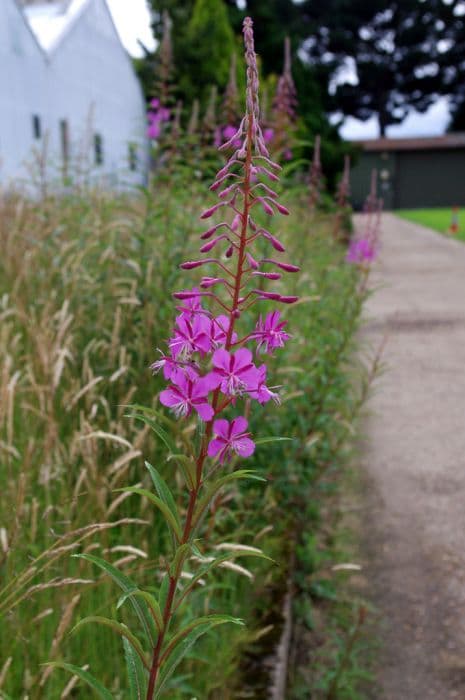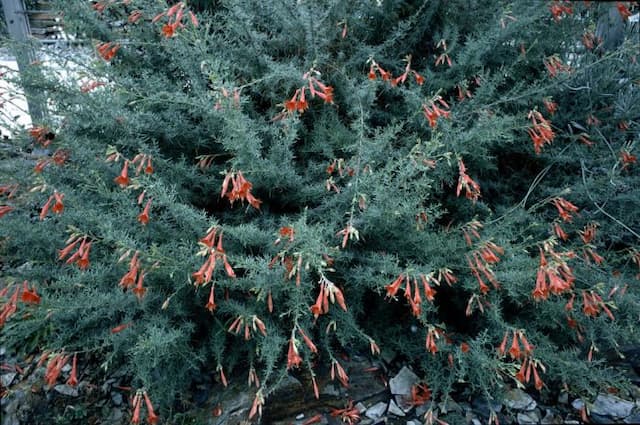Sundrops Oenothera fruticosa subsp. glauca

ABOUT
Commonly known as the Narrowleaf Evening Primrose, this plant is distinguished by its unique flowers and foliage. It boasts a vibrant array of yellow flowers that typically bloom in the late afternoon to evening, hence its name. Each flower has four broad petals that form a cross shape and a yellow center with delicate stamens and pistils. Its leaves have a narrow, lance-shaped profile and are often a deep green shade, sometimes with a bluish or waxy cast. The plant's leaves are arranged alternately on the stem, giving it a bushy appearance. The stems themselves can be upright or slightly spreading and are sometimes tinged with red or purple, adding to the visual interest of this species. This perennial plant displays a charming character that is both wild and delicate, providing a burst of color in the landscape.
About this plant
 Names
NamesFamily
Onagraceae
Synonyms
Narrowleaf Evening Primrose, Sundrops
Common names
Kneiffia fruticosa, Oenothera fruticosa var. glauca, Oenothera fruticosa var. piloselloides, Oenothera piloselloides, Oenothera tetragona, Xylopleurum fruticosum.
 Toxicity
ToxicityTo humans
The most common common name for Oenothera fruticosa subsp. glauca is the Narrowleaf Evening Primrose. There is no widely recognized toxicity of Narrowleaf Evening Primrose to humans. In fact, parts of the plant are used in traditional medicine and edible products. However, as with any plant, individual allergies and sensitivities can exist, and it is advisable to exercise caution and consult with a medical professional before consuming or using any part of the plant for medicinal purposes.
To pets
The most common common name for Oenothera fruticosa subsp. glauca is the Narrowleaf Evening Primrose. This plant is generally not considered toxic to pets. However, it's always prudent to prevent pets from ingesting plants, as individuals may have different reactions and some plants can cause gastrointestinal upset or other issues if consumed in large amounts. If your pet ingests part of the plant and shows any signs of distress, it is advisable to contact a veterinarian.
 Characteristics
CharacteristicsLife cycle
Perennials
Foliage type
Deciduous
Color of leaves
Green
Flower color
Yellow
Height
1-3 feet (0.3-0.9 meters)
Spread
1-3 feet (0.3-0.9 meters)
Plant type
Shrub
Hardiness zones
4-9
Native area
North America
Benefits
 General Benefits
General Benefits- Attracts pollinators - Oenothera fruticosa subsp. glauca is known for attracting bees, butterflies, and other beneficial insects that are crucial for plant pollination.
- Drought tolerance - This plant is drought-resistant, making it suitable for xeriscaping and low-maintenance gardens where water conservation is important.
- Erosion control - It can help stabilize soil and prevent erosion due to its spreading habit and root system which holds soil in place.
- Ornamental value - With its bright yellow flowers, Sundrops provide aesthetic beauty to gardens and landscapes.
- Wildlife habitat - It offers shelter and food to a variety of wildlife, including birds and small mammals.
- Low maintenance - Sundrops are considered low maintenance, requiring minimal care once established in the right conditions.
 Medical Properties
Medical Properties- Antispasmodic: Traditionally used to help relax and ease muscle spasms.
- Astringent: May be used to tighten tissues and reduce secretions in the body.
- Sedative: Historically used to promote calmness and help with sleep.
- Anti-inflammatory: Can be used to reduce inflammation in the body.
 Air-purifying Qualities
Air-purifying QualitiesThis plant is not specifically known for air purifying qualities.
 Other Uses
Other Uses- Oenothera fruticosa subsp. glauca, commonly known as the Sundrops, can serve as a natural dye for fabrics, yielding a yellow or green hue depending on the mordant used.
- The nectar and pollen of the Sundrops are a significant food source for various pollinators, including bees and butterflies, which helps support local ecosystems.
- The plant's vibrant flowers can be used for ornamental purposes in arrangements or pressed for crafts, providing a bright splash of color to creative projects.
- Sundrops can act as ground cover in garden design due to their spreading habit, which helps reduce soil erosion and suppresses weed growth.
- The seeds of Oenothera fruticosa subsp. glauca can be eaten after roasting and have been historically used by Native Americans as a food source.
- This plant acts as an ecological indicator species, helping scientists to understand health of a particular ecosystem where it grows naturally.
- The leaves of Oenothera fruticosa subsp. glauca can be used to feed certain species of caterpillars, such as the White-lined sphinx moth larvae.
- When planted alongside vegetable gardens, Sundrops can attract beneficial insects that prey on garden pests, providing natural pest control.
- The fibrous stems of the plant can be used in the construction of small handcrafted items, such as baskets or mats, following traditional practices.
- Sundrops can help stabilize banks and slopes in restoration projects or in settings prone to disturbance due to their hardy and resilient nature.
Interesting Facts
 Feng Shui
Feng ShuiThe Sundrops are not used in Feng Shui practice.
 Zodiac Sign Compitability
Zodiac Sign CompitabilityThe Sundrops are not used in astrology practice.
 Plant Symbolism
Plant Symbolism- Resilience: Oenothera fruticosa subsp. glauca, commonly known as the Narrowleaf evening-primrose, often grows in tough conditions, symbolizing the ability to endure and thrive despite challenges.
- Patience: As a plant that blooms in the evening and closes by the morning, it represents patience and the importance of waiting for the right moment.
- Beauty: With its attractive yellow flowers, it symbolizes inherent beauty and the idea that beauty can flourish in unlikely places.
- Healing: Due to its traditional use in herbal medicine, it carries the symbol of healing and soothing of afflictions.
- New Beginnings: The bloom’s daily cycle of opening in the evening represents hope and the start of something new.
 Water
WaterSundrops (Oenothera fruticosa subsp. glauca) prefer a well-draining soil that is kept evenly moist but not waterlogged. During the growing season, water the plant thoroughly once a week, providing about 1-2 gallons depending on the size of the plant and the weather conditions. In hot, dry periods, the frequency may increase to twice a week. Over the winter, reduce watering substantially, allowing the soil to dry out a bit between watering sessions, which may be spaced out to once every two weeks.
 Light
LightSundrops thrive in full sun conditions, requiring at least 6 to 8 hours of direct sunlight per day. The ideal spot for these plants would be an area that receives unobstructed sunlight throughout the day, such as a southern-facing garden spot. While they can tolerate some light shade, too little sun may result in fewer blooms.
 Temperature
TemperatureSundrops are quite hardy and can tolerate a range of temperatures, surviving winters where temperatures may drop to around -30°F. They grow best in temperatures ranging from 60°F to 85°F. They can thrive in the heat of summer but may require additional watering during extreme heat above 90°F.
 Pruning
PruningSundrops should be pruned to maintain their shape and encourage bushier growth. Pruning should be done in early spring, cutting back the plant by about one-third of its size. Deadheading, or removing spent flowers, will promote continuous blooming throughout the summer. After the first killing frost, you can cut back the plant to ground level to keep the area tidy.
 Cleaning
CleaningAs needed
 Soil
SoilSundrops prefer well-draining soil with a pH ranging from 5.5 to 7.0. The best soil mix for Sundrops would include equal parts of garden soil, peat moss or coir, and sharp sand or perlite to ensure proper drainage. Regular garden soil can be improved with the addition of organic matter to enhance its structure and fertility.
 Repotting
RepottingSundrops typically do not require frequent repotting and can thrive in the same pot for several years. Repotting should be done only when the plant has outgrown its current container or the soil has degraded, generally every 2 to 3 years.
 Humidity & Misting
Humidity & MistingSundrops are tolerant of a wide range of humidity levels and do not require any special humidity conditions. They can thrive in the average ambient humidity found in most outdoor environments.
 Suitable locations
Suitable locationsIndoor
Place Sundrops near a sunny window.
Outdoor
Full sun to partial shade in well-drained soil.
Hardiness zone
4-9 USDA
 Life cycle
Life cycleOenothera fruticosa subsp. glauca, commonly known as the narrowleaf evening-primrose, begins its life cycle as a seed, which upon germination in early spring, sprouts into a small seedling. The seedling grows into a rosette of leaves close to the ground, and as it matures, it develops a sturdy stem and a larger rosette. In late spring to early summer, the plant produces yellow flowers that open in the evening and close by the next noon, which are then pollinated by night-flying insects such as moths. Following pollination, the flowers develop into elongated seed capsules throughout the summer. As the seed capsules mature, they eventually split open, releasing the seeds which are then dispersed by wind or animals. The plant is a perennial and after seed dispersal, it will resume growth from its root system the following spring, repeating the cycle.
 Propogation
PropogationPropogation time
Spring to Summer
The sundrops, known scientifically as Oenothera fruticosa subsp. glauca, are usually propagated through seed sowing. To propagate sundrops by seed, one would typically gather seeds following the fading of the blooms in late summer or early fall. The collected seeds can be directly sown outdoors in a prepared seedbed, slightly pressed into the soil but not covered, as they require light for germination. In geographic areas with cold winters, the seeds can be stratified by placing them in a moistened growth medium within a sealed container and storing in a refrigerator for about 6 to 8 weeks before planting. This cold stratification simulates winter conditions and helps break the seed dormancy. After stratification, the seeds can be sown in early spring after the risk of frost has passed. The seeds will germinate when the soil temperature reaches around 70°F (21°C), and as they grow, thinning may be necessary to allow adequate space for mature plants.









